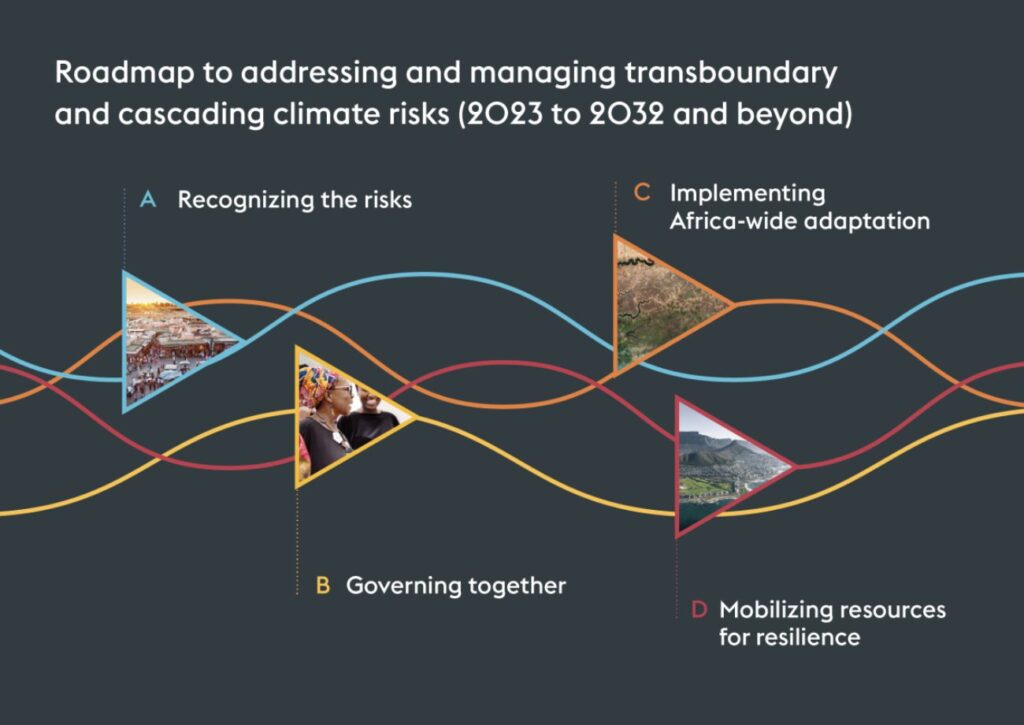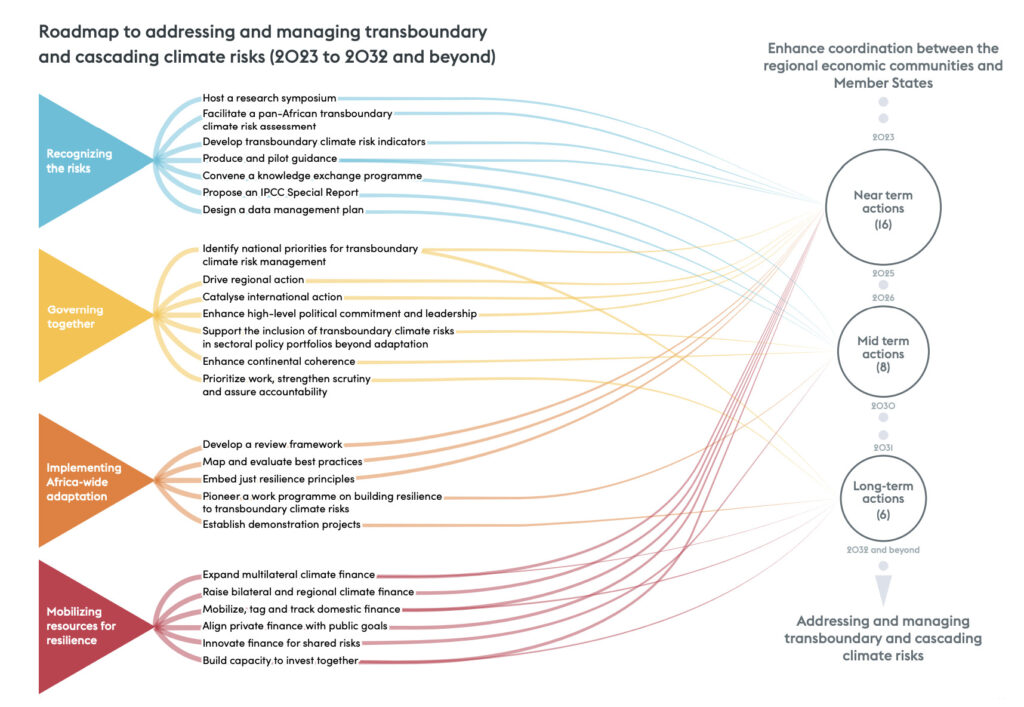A Roadmap for African Resilience

Transboundary and cascading climate risks manifest when the impacts of climate change in one place generate adverse effects in another – cascading across both national borders and administrative boundaries to generate risks to people, ecosystems, economies, infrastructure, trade and finance. They also occur when responses to climate change (both mitigation and adaptation actions) have consequences beyond the jurisdictions where they are implemented.
African policymakers, experts and practitioners at the frontline of adaptation have begun to consider the implications of transboundary and cascading climate risk. This roadmap proposes key actions towards realizing an ambition of the African Union Climate Change and Resilient Development Strategy and Action Plan (2022–2032) to “Enhance coordination between the Regional Economic Communities and Member States in addressing and managing transboundary and cascading climate risks”.
This article is an abridged version of the original text, which can be downloaded from the right-hand column. Please access the original text for more detail, research purposes, full references, or to quote text.
The process
This roadmap is the result of a collaboration between many institutions and individuals. The actions proposed in the roadmap were generated at a multi-stakeholder policy dialogue held in July 2023 in Nairobi, Kenya. This brought together 30 representatives from organizations at the forefront of dealing with transboundary climate risks in Africa, including Regional Economic Communities (RECs). They are also informed by world- leading experts on transboundary climate risk management, and an in-depth political economy analysis of the cooperation and integration mechanisms, policies and financing instruments of the African Union (AU) and the RECs.
The actions proposed are neither exhaustive nor representative of the views of all relevant stakeholders. The process of producing the roadmap was necessarily limited in scope, and it should be considered an indicative guide that should be strengthened and improved over time.

Learn more about the process behind the roadmap on pages 7-9.
The roadmap
This roadmap has been designed through a participatory process to enhance coordination in addressing and managing transboundary climate risks in Africa. It does so by setting out a series of four interdependent ‘mini roadmaps’, which each identify priority actions for the near, mid and long term:
Mini roadmap 1: Recognizing the risks
This describes a pathway to generate the necessary knowledge, data and monitoring:
- Transboundary climate risks are a new topic in climate risk and adaptation research. Despite increasing awareness about the transboundary climate risks faced by African countries – as raised in NAPs, national adaptation programmes of action (NAPAs) and NDCs – critical gaps in evidence hold back the design of effective governance arrangements for their management.
- The lack of evidence on specific transboundary and cascading climate risks, including the means to assess their significance, renders decisive political action to manage such risks both less likely and less sustainable (i.e. open to challenge).
- The task for the research community is to cut through this complexity to deliver robust and yet practical recommendations for policymakers on how to build resilience to transboundary climate risks. This will require a ‘learning by doing’ approach, based on participatory multi-stakeholder engagement and peer-to-peer exchange within and beyond the continent.
Please refer to pages 18-21 to explore this mini roadmap and its calls for action in more detail.
Mini roadmap 2: Governing together
This outlines measures to support African policymakers’ leadership, communication and coordination:
- Attention to these risks, and the development of actions to manage them, need to filter down to policymakers at regional, national and sub-national levels of governance and across diverse policy domains, from trade and finance to security and foreign policy.
- The effective governance of transboundary climate risk will require bold institutional reforms.
- Stronger vertical and horizontal coordination and communication is encouraged for the implementation of the actions outlined in this mini roadmap.
- Political leadership and the prioritization of ‘precautionary’ risk management are also imperative. Adaptation should be placed on a par with mitigation in climate diplomacy.
Please refer to pages 22-25 to explore this mini roadmap and its calls for action in more detail.
Mini roadmap 3: Implementing Africa-wide adaptation
This illustrates approaches and priorities to upscale adaptation action:
- Implementing adaptation action to transboundary climate risks without the full knowledge and data required to inform risk reduction and management is a significant challenge. However, waiting for perfect information and comprehensive data on transboundary climate risks is not an option, given the complexity involved in such a task and the mounting costs of inaction.
- Even with limited information, decisive action to address transboundary climate risks is possible: a proactive and precautionary approach to climate adaptation is needed.
- Organizations managing adaptation projects and programmes across the continent require support to assess the exposure of their portfolios to transboundary climate risks and to pilot experimental projects dedicated to their management.
Please refer to pages 26-29 to explore this mini roadmap and its calls for action in more detail.
Mini roadmap 4: Mobilizing resources for resilience
This maps avenues for the generation and harnessing of finance and capacity:
- The project-based, time-bound and country-driven nature of most current funding models limits opportunities for countries to share ownership of adaptation programmes and this impedes their potential to achieve transformative and systemic resilience to transboundary climate risks.
- Multilateral funders, bilateral partners, the AU, RECs and African governments all need to play their part in harnessing these opportunities and mobilizing requisite resources. Both contributors and recipients stand to benefit from building systemic resilience in an interdependent world.
- Many opportunities exist to tap non-climate funds for the management of specific transboundary climate risks – including development finance and investment from the private sector and philanthropy – particularly as donors take steps to ‘proof’ their own investments from transboundary climate risks.
- The challenges of capacity building and the mobilization of requisite technologies to manage transboundary climate risks across all sectors and scales requires concerted effort and financial support.
Please refer to pages 30-33 to explore this mini roadmap and its calls for action in more detail.

Transboundary Climate Risks a key priority for African Resilience: 5 perspectives
Katy Harris
Lwembe Mwale
Eng. Coletha Ruhamya
Ishaku Huzi
George Wamukoya
Further resources
- Suggested Citation:Adaptation Without Borders (2023). A roadmap for African resilience: addressing transboundary and cascading climate risks. Stockholm Environment Institute, Stockholm.
- Policy brief: How can Africa manage the transboundary climate risks it faces?
- An African perspective on transboundary and cascading climate risks
- The Global Transboundary Climate Risk Report
- Multilateral adaptation finance for systemic resilience: addressing transboundary climate risk
- Pastoralism, farming and a changing climate in the Sahel region

Comments
There is no contentYou must be logged in to reply.